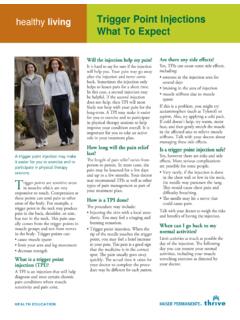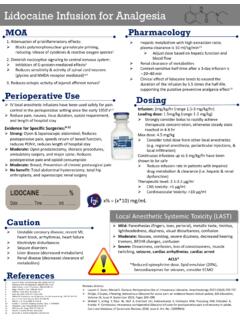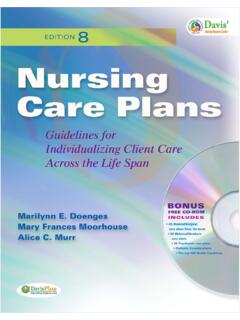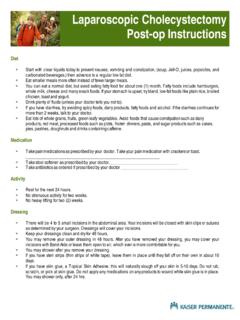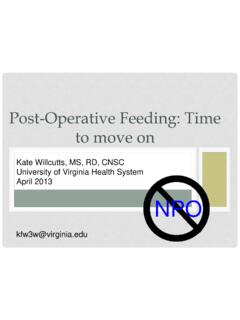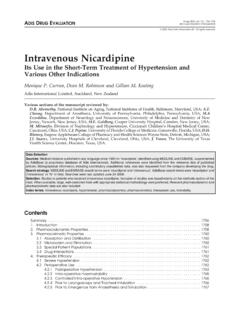Transcription of Kaiser Permanente: Cholecystectomy Post-op Instructions
1 Cholecystectomy Post-op Instructions Diet Start with clear liquids today to prevent nausea, vomiting and constipation, (soup, Jell-O, juices, popsicles, and carbonated beverages.) then advance to a regular low fat diet. Eat smaller meals more often instead of fewer larger meals. You can eat a normal diet, but avoid eating fatty foods for about one (1) month. Fatty foods include hamburgers, whole milk, cheese and many snack foods. If your stomach is upset, try bland, low-fat foods like plain rice, broiled chicken, toast and yogurt. Drink plenty of fluids (unless your doctor tells you not to). If you have diarrhea, try avoiding spicy foods, dairy products, fatty foods and alcohol. If the diarrhea continues for more than 2 weeks, talk to your doctor. Eat lots of whole grains, fruits, and green leafy vegetables. Avoid foods that cause constipation such as dairy products, red meat, processed foods such as pizza, frozen dinners, pasta, and sugar products such as cakes, pies, pastries, doughnuts and drinks containing caffeine.
2 Medication T ake pain medications as prescribed by your doctor. T ake your pain medication with crackers or toast. _____ T ake stool softener as prescribed by your doctor. _____ T ake antibiotics as ordered if prescribed by your doctor _____ Activity Rest for the next 24 hours. Walk to bathroom and other short distances only, on night of surgery. On next day, get up and walk as tolerated. Do not make sudden position changes; if lying down; sit for a minute before standing. No lifting greater than 10 pounds for 6 weeks. Dressing Keep your dressing clean and dry for 48 hours. You may remove the outer dressing after 48 hours. If you have a clear plastic dressing, keep on for 48 hours, then remove. If you have steri strips (thin strips of white tape), leave them in place until your appointment with your doctor. T he steri strips may fall off on their own in approximately 10 days.
3 Cholecystectomy Post-op Instructions Bathing You may shower after 48 hours when dressings are removed. No bathing, immersion or swimming for at least four (4) weeks. What to Expect You may feel sleepy, rest for the first 24 hours. You may have some nausea or vomiting the day of surgery, but this should not persist beyond the day AFT ER surgery. You may have a sore throat, if you received general anesthesia It may take a few days before you have a bowel movement. Bowel irregularity is expected with pain medication. T ake stool softener as ordered for constipation. You may also experience diarrhea, especially if eating foods high in fat. T his should gradually resolve, allowing your diet to return to normal. Sterile Suction Drain (JP Drain) If your gallbladder was infected, your surgeon will insert a tube in the incision to drain fluid out of the surgical site.
4 T he tube will have a bulb-like devise at the end of the tube to collect the fluid. When you return for a postoperative visit your surgeon will remove the drain. How to Empty the Sterile Suction Drain: Before and after you empty the drain reservoir wash your hands well with soap and running water. Pay special attention to rubbing your fingers, fingernails and the backs of your hands. Hand washing is an important step to help prevent infection. Empty your drain reservoir when you get up in the morning and before you go to bed at night. Pour the contents of the reservoir into the measuring cup, record the amount of drainage. Bring this record to your next visit with your surgeon. Squeeze the sides of the reservoir to remove all air. Reinsert the cap. T he drain works properly only when the sides are flattened and a light suction is created. Pin the reservoirs to your clothing to prevent pulling on the tubing.
5 Miscellaneous No alcohol or driving for 24 hours after surgery or while taking pain medicine. Do not make any personal or business decisions for 24 hours. You should have a responsible adult with you for the rest of the day and night. Cholecystectomy Post-op Instructions Possible Problems Call your surgeon if: Unable to drink liquids in the morning because of nausea. Unable to urinate eight hours after your surgery. Your temperature is greater than degrees F. You notice excessive bleeding or unexpected drainage from the wound site. You notice extreme redness or warmth around your incision sites. You notice wound edges open or separate. Your pain is not relieved by pain medication. Call your surgeon if you have any of the following symptoms: When it Might Occur Possible Cause Severe right upper abdominal pain Within 48 hours Ret ained c ommon bile duc t stone, or Post-op pain from musc le injury Right upper abdominal pain inc reasing over t ime Hours to days after the proc edure Delayed bleeding or bile leak Right upper abdominal pain with or aft er eat ing.
6 Y ellow discoloration of skin or eyes (jaundice) May occur weeks later Gallstones in c ommon duc t Temperature > degrees F Wit hin t wo weeks Infec tion within the abdomen or in one of the inc isions Telephone numbers to call with Problems or Questions Surgery Clinic: Department 286 Mon Fri, 8:30 to 5 (408) 851-2000 Medical Offices Call Center Mon Fri, After Business Hours, Weekends and Holidays (408) 554-9800 Emergency Department Open 24 hours (408) 851-5300 A nesthesia Service Line Open 24 hours; your call will be returned within one business day. (408) 851-6020 Cholecystectomy Post-op Instructions Follow-up Appointment Name: Place: Date: Tim e: Return to Work: M edical Provider: 2011, The permanente Medical Group, Inc. All rights reserved. Santa Clara Health Education. ######### (Revised 10-11) RL







